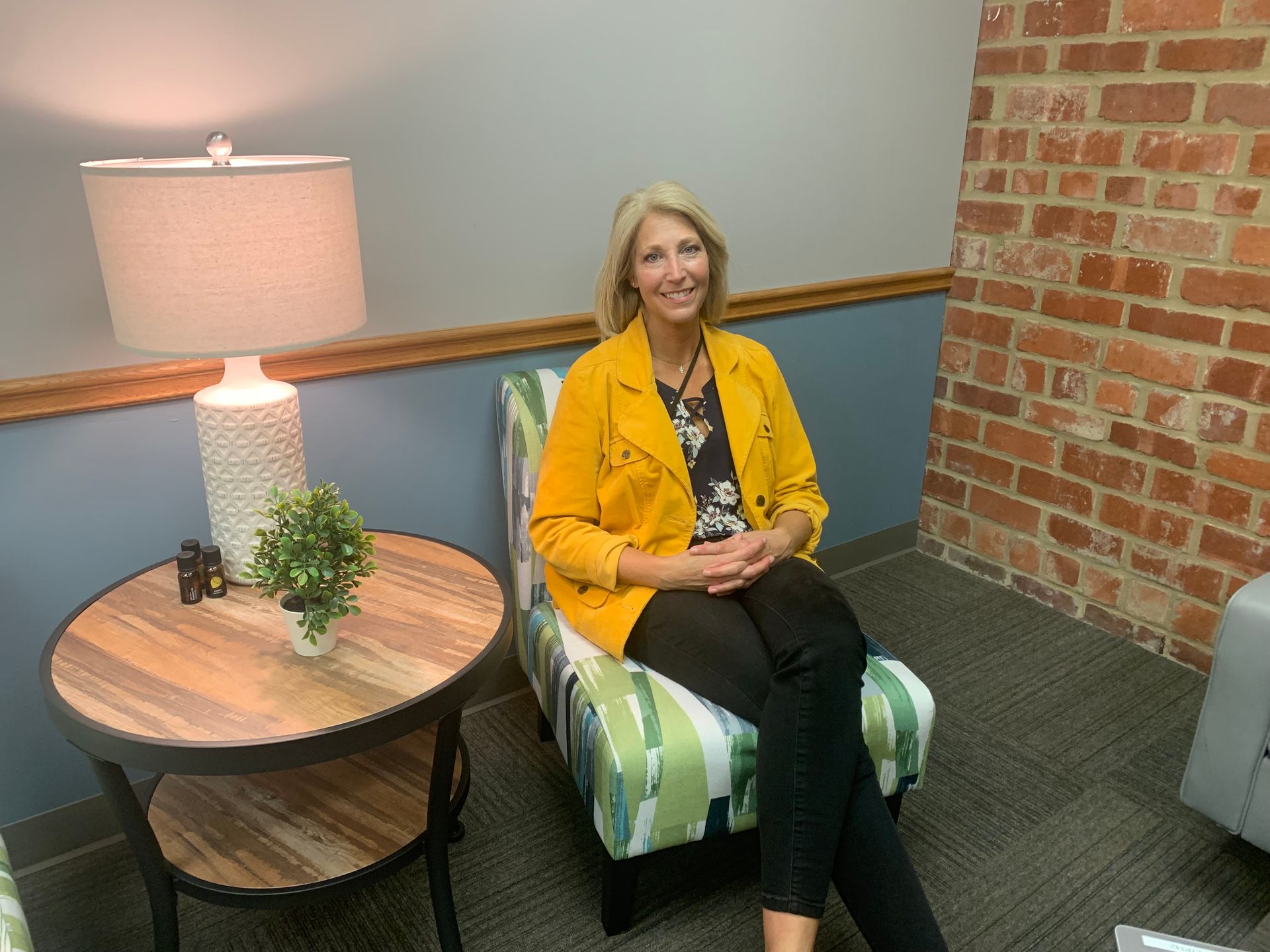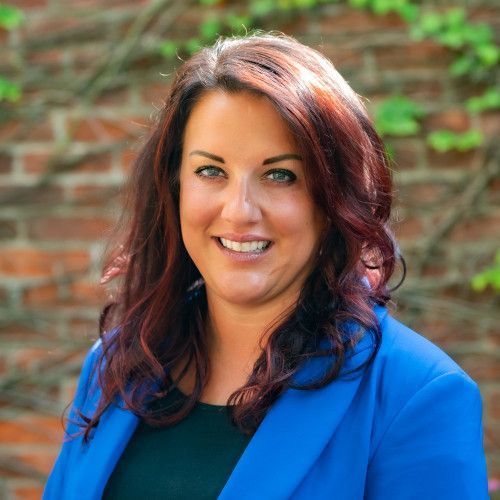Address
1985 Eagle Pass Wooster, Ohio 44691
Phone
Wayne County: 330.264.2527
Holmes County: 330.674.5772
To Access 24Hour Crisis Services Related to Substance Abuse, Call our local Treatment Navigator:
Wayne/Holmes County:
330.466.0678
Homeless Navigator: 330.749.2638
PRESS / MEDIA

Piper Davidson, OneEighty’s jail services manager, has been named Ohio Crisis Intervention Team Health Professional of the Year by the Northeast Ohio Medical University’s Criminal Justice Coordinating Center of Excellence. She was nominated by Assistant Wooster Police Chief Scott Rotolo on behalf of the NAMI Wayne and Holmes Counties CIT Advisory Council and the Wooster Police Department
WOOSTER -- Piper Davidson thinks of herself as someone along the lines of an air traffic controller -- if the Wayne County jail had an air traffic controller.
Davidson, who has been with OneEighty since fall of 2013, provides service coordination for inmates with persistent and severe mental illnesses.
But once she explains it, you’d be inclined to think an actual air traffic controller has the easier job.
Davidson emphasizes she does not do her work in a vacuum: she relies on law enforcement, hospitals, mental health providers, the Mental Health & Recovery Board of Wayne and Holmes Counties, the “boots on the ground” workers at the Salvation Army and the Trinity United Church of Christ daily breakfast, housing case managers and providers, group homes, regional psychiatric facilities.
The list goes on.
And beyond all that, Davidson provides the mental health overview section of the 40-hour law enforcement Crisis Intervention Team training offered by NAMI, which is financially supported by the Mental Health & Recovery Board. Her angle, she said, is “these are human beings with a mental health condition.”
It’s easy for officers to lose sight of that, she said, especially if they’re being yelled at or having things thrown at them. For them, “it feels very personal,” while Davidson said, “I recognize that as a symptom of a severe mental illness and I do not take it personally.”
So adept is Davidson at what she does that she recently was named the Ohio Crisis Intervention Team Health Professional of the Year by the Northeast Ohio Medical University’s Criminal Justice Coordinating Center of Excellence. She was nominated by Assistant Wooster Police Chief Scott Rotolo on behalf of the NAMI Wayne and Holmes Counties CIT Advisory Council and the Wooster Police Department
“Piper has consistently demonstrated a strong commitment to the goals of the Ohio CIT programs. She has shown exceptional dedication to the CIT and actively worked towards improving outcomes for individuals in crisis,” he wrote in his nomination letter. “I have lost count of how often she advocates for inmates and others she has linked with crisis services to ensure they have a successful outcome. She understands how important it is for us to move toward transforming our local crisis response system to one where law enforcement and jails are used when there is an imminent threat to safety or serious criminal matter and that the criminal justice system is not the appropriate system for many.”
“I was humbled, honored. I felt honored,” Davidson said of receiving the award. “I feel like we all deserve this, countless names of people, people I don’t even know. Everyone who has any part in wanting to help our fellow human beings live their best lives.”
The number of severely mentally ill persons who end up in jail has been rising steadily across the country over the years, a fact Davidson believes had its start in the deinstitutionalization movement of the 1980s. Ironically, her late father was once chief of police at the former Apple Creek Developmental Center. “He really dealt with the very same population,” she said. “It’s funny how it’s come full circle.”
Davidson had been working at the jail as an outpatient counselor and also completed diagnostic assessments for the CADET program when the job of justice service manager came available.
“I was excited honestly …” she said. “But I was anxious. I was excited for the shift over to the mental health focus.”
Most days, it’s a lot.
Davidson’s job is to keep data on referrals and try to keep track of a population in which “most are repeat offenders, many are homeless, many are in the emergency room” while arrangements can be made to move them somewhere else.
“Somewhere else” could be a group home or a psychiatric facility. The problem is openings in both are difficult to find and chances are the severely mentally ill person is released from the jail before a plan can be established. Rotolo, Davidson said, noticed post-pandemic that there were people regularly cycling in and out of the jail and began trying to coordinate efforts to keep them out of incarceration. “Jail was the hub everyone kept going in and out and in and out,” she said.
While there are a few with more concerning offenses, the majority are arrested on suspicion of criminal trespass at a place which already has a no-trespass order against them. They’re there, Davidson said, often because they are not taking their medications, they have received no psychiatric services that would lead to medication, because they are homeless or some combination of any of that.
Jail is not the answer, either. The severely mentally ill inmate likely is not compliant with medication and can be paranoid or delusional and often is vulnerable. “For everyone’s safety, we have to isolate them,” Davidson said.
And therein is another problem: There are only four medical observation cells, one for a suicide watch. Some of that problem will be alleviated with the coming jail expansion.
Davidson said she and her cohorts will try to set the inmate up with as many services as they can to stabilize them as they leave the jail, but often there is no next step. “It’s just a broken system for these folks,” she said, though she is ever thankful for the help jail leadership provides in enabling her and other mental health workers to assist inmates in need of services.
It would seem to be depressing work and sometimes, Davidson said, it is. But she pins her hopes to the small victories. “Once upon a time, they came from family; they had people who loved them,” she said, and that’s what she tells officers in CIT training, because they are likely seeing the illness, not the person buried underneath.
She recalled hearing a presentation from a man with lived experience who had gotten help to get his bipolar I illness under control, had learned to manage it and was leading a fruitful life. He proves, Davidson said, that recovery is both possible and ongoing.
“This is such important work that we’re doing,” Davidson said. “We’re working with human lives.”
Don’t let March Madness become a gambling problem, Anazao specialists say
WOOSTER -- With March Madness in full swing, Anazao Community Partners, a non-profit organization serving Wayne and Holmes Counties, Ohio, is urging residents to be aware of the increased risks of online gambling addiction.
The National Council on Problem Gambling estimates that nearly 4 million adults in the U.S. struggle with a gambling problem, and rates are projected to rise with the ease of access to online gambling platforms. A recent study by the NCPG revealed that problem gambling rates are twice as high among sports bettors compared to gamblers in general.
“Gambling takes many forms but the core is to take a risk or a chance in order to get a higher payout than you put in,” says Joseph Messner, LPCC-S, adult services provider at Anazao Community Partners.
Increased Risks of Online Sports Betting:
- Convenience and Accessibility: Online platforms make gambling readily available 24/7, increasing the risk of impulsive betting and excessive gambling behavior.
- In-Game Betting: The ability to wager throughout a game can lead to chasing losses and larger bets. “Players may assume that it’s just part of the game that they’re playing and not associate their choices with gambling,” Messner said.
- Focus on Entertainment Value: Online sports betting can blur the lines between entertainment and gambling, making it easier to lose track of time and money spent.
Recognizing Problem Gambling:
- Preoccupation with gambling thoughts or urges to gamble
- “Needing to gamble with increasing amounts of money to achieve the same level of excitement or to get a higher and higher payout,” said Messner.
- Repeated unsuccessful efforts to control, take a break from, or quit gambling
- Gambling causing relationship problems, job loss, or financial difficulties
- Lying to family or friends to hide gambling behavior
- Chasing losses or borrowing money to gamble
- Feeling restless or irritable when unable to gamble
“How we talk about problem gambling is what makes all the difference in supporting folks who may be struggling with sports betting and other gambling,” said J Greg Morrison, prevention and communication specialist at Anazao Community Partners. “Saying things like, ‘you sound like you might be an ‘addict’ or ‘a problem gambler’ can make someone defensive and resistant to recognizing or having a conversation, much less seeking treatment for their struggles with gambling. It’s more productive to talk in terms of their behavior versus how the behavior defines them.
“The legalization of sports betting makes it all the more important to highlight the risk factors of gambling in middle or high school especially around events like March Madness,” continued Morrison. “Introducing youth to Ohio’s own ‘Change The Game’ https://changethegameohio.org/education/education-for-youth/ resource. Pause Before You Play https://pausebeforeyouplay.org/ is the resource for adults and is the best place for any parent, teacher, coach, or other caring community member to start to learn more about problem gambling and how to reduce the risk for their loved ones.”
Problem gambling seems to be increasing, according to specialists and researchers, as sports betting was recently legalized in Ohio. “It also often seems to go unnoticed or is not brought up, as it tends to be viewed as ‘okay’ because it’s legal,” says Garrett Barr, LISW-S, specialized outpatient provider at Anazao Community Partners. “It’s okay to feel like you or your family member has a problem, and it’s okay to feel like you or your family member should receive help, because the help is available.”
Anazao Community Partners, supported by the Mental Health and Recovery Board of Wayne and Holmes Counties, has licensed professionals trained to identify and treat problem gambling. If you or someone you know is struggling with gambling addiction, please call Anazao at 330-264-9597 to connect to same-day support.
Placement Crisis: Children are younger, problems more acute while beds, workers are harder to find
Esther Hawkins remembers a first-thing-in-the-morning office conversation she used to have with Judy Wood.
Wood, then the executive director of the Mental Health & Recovery Board of Wayne and Holmes Counties, would ask Hawkins, “How’s it going?” accompanied by a knowing look.
“The kids are safe,” would come the reply from Hawkins, the executive director of the Wayne County Family and Children First Council.
But keeping those kids safe comes at a cost – and a growing one.
The number of children in out-of-home placements has actually gone down in Wayne and Holmes counties over the past decade. Those numbers, Hawkins said, are deceiving. The Wayne FCFC has been tracking Wayne County numbers the first Friday of every month and that data shows the highest reported number – 215 – was in January of 2013. Most recently, in December of 2023, that number was 111. In Holmes County, the Department of Job & Family Services reports a high of 67 children in placement in 2019 dropped to 48 last year.
But many of these children are getting younger when they enter care and have greater needs than ever.
The average cost per day for a youth in residential treatment is $320 and 14 Wayne County youths receive this type of care. The FCFC reports seven of those receive federal money that covers about 60 percent of the cost. All 14 have mental health disorders, four have co-occurring developmental disabilities, one has significant medical concerns and three are court involved.
The average age? Just over 12 years.
Another six are placed in homes with providers from the developmental disabilities system. All have mental health disorders, five have developmental disabilities and one has a medical disability. One is court involved.
Both counties have Family and Children First Councils, designed to provide service coordination. Depending on their level of need children can be placed in kinship foster care, traditional foster care, treatment foster care, residential care, juvenile detention, Department of Youth Services, providers licensed by Board of Developmental Disabilities or hospitals.
Regardless, Hawkins said, “For any kid in out-of-home placement, the ultimate goal is to return kids to community.”
The placement crisis, Hawkins said, is unfortunately paired with a mental health crisis coupled with a pandemic. Data from the Centers for Disease Control show the number of residential treatment facilities nationwide declined by 30 percent in the last decade, while in 2020 – the first year of the pandemic – emergency room visits for children ages 5 to 11 increased by 24 percent and by 31 percent for children ages 12 to 17.
The Family First Prevention Services Act included historic reforms designed to keep children in their homes, while also focusing on reducing out-of-home placement, the most restrictive of which would be a Psychiatric Residential Treatment Facility (PRTF), for which Medicaid may pay.
But, Hawkins noted, PRTF beds also require the highest level of staffing, which is difficult in a behavioral health care system already taxed for personnel. Even traditional foster care homes have been on decline; again, affected by the pandemic when families had their own children at home 24 hours a day, seven days a week.
It is a perfect storm for a crisis.
Last spring, a Wayne County teen spent a month in Cleveland’s University Hospitals Rainbow Babies & Children’s Hospital. The youth was ready to be discharged, but the mother, working with child welfare officials, was not able to find a treatment facility and refused to pick up the youth until she could secure a safe option.
Eventually, due to the hospital filing abandonment charges, the Wayne County Juvenile Court placed the teen in the custody of Wayne County Children Services, and hospital officials brought the youth to the agency office. With no identified placement, the teen stayed two nights at the agency before custody was returned to the mother. The mother then had to take the child home due to lack of a therapeutic placement.
Two days later, police were called and the youth was arrested for domestic violence and stealing the mother’s car. The teen, still waiting for treatment, was taken to juvenile detention.
The problems in Wayne County are mirrored in Holmes County, according to Holmes County Commissioner Dave Hall.
When a child enters the placement world, the costs are first billed to insurers, if any, but the remaining costs are borne by the county of their residence. And to add to the paperwork, any children needing PRTF placement must be assessed by the Ohio Resilience through Integrated Systems and Excellence (Ohio RISE) a state-approved managed care provider. There are 254 QRTP FACILITIES– 251 in Ohio and another three out of state -- available for placements. There are only 12 PRTF beds in Ohio.
Costs billed back to the counties range anywhere from $100 per day to $1,350 depending on the level of care. Wayne and Holmes counties each have partners – like the Mental Health and Recovery Board – that pool funds to pay for out-of-home placements. In addition, Wayne County has a Children Services levy. Holmes County has no such levy, so when the money runs low, Holmes JFS goes to the county commissioners for money from the county’s General Fund. Last year, Holmes JFS placement cost totaled nearly $1.7 million. In Wayne County, that number was $5.3 million.
Two years ago, Wayne County opened Asha House in Wooster for respite, step down or emergency placements. The four-bedroom house is maintained by the Wayne Metropolitan Housing Authority, staffed by a provider licensed by the Department of Developmental Disabilities and controlled by FCFC and its partners. Children typically stay there three days for emergency placements or respite and up to three months when stepping down from residential to the community.
But it isn’t set up to handle the most aggressive children. Those go to hospitals, treatment stabilization facilities, home -- wherever a placement can be found. “We hate moving kids,” from one placement to another, Hawkins said, but “You do what you do to keep kids safe.

Contact Us
Address
1985 Eagle Pass Wooster, Ohio 44691
Phone
Wayne County: 330.264.2527
Holmes County: 330.674.5772
To Access 24-Hour Local Crisis Services:
For immediate concerns, please contact:
Crisis/Mobile Response: 330-264-9029
Substance Use Crisis: 330-466-0678
Recovery Assistance: 330-464-1423
Housing Navigator: 330-749-2638
Emergency Services:
911
National Resources:
Crisis Text Line: Text 4HOPE to 741-741
Veterans Hotline: Dial 988 and Press 1 or Text 838-255
The Trevor Project: 1-866-488-7386
Copline:
1-800-267-5463
All Rights Reserved | Mental Health & Recovery Board of Wayne & Holmes Counties | This site is powered by Bluefoot.
